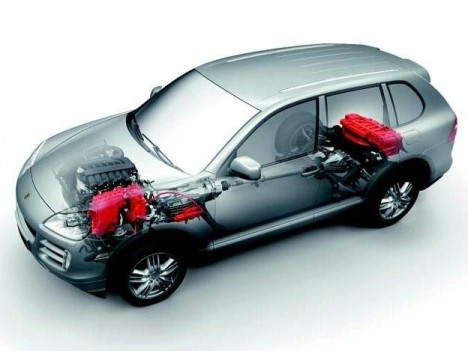Porsche Cayenne S hybrid
New Porsche Cayenne S hybrid will finally came to market in 2010. According to the German automaker, the hybridized Cayenne will emit some 20 percent less C02 than comparable combustion engine vehicles with similar power output. Covering a 0-to-100 km/h sprint in just 6.8 seconds, it will earn its ‘S’ designation by delivering V8 performance […]

New Porsche Cayenne S hybrid will finally came to market in 2010.
According to the German automaker, the hybridized Cayenne will emit some 20 percent less C02 than comparable combustion engine vehicles with similar power output. Covering a 0-to-100 km/h sprint in just 6.8 seconds, it will earn its ‘S’ designation by delivering V8 performance and four-cylinder efficiency, all while complying with the Ultra Low Emission Vehicle II emission standards.
Cayenne S Hybrid will roll freely at highway speeds without the combustion engine on, greatly minimizing engine emissions and fossil fuel consumption. This differs from current hybrid concepts that deliver benefits mainly in city traffic.
In cooperation with Volkswagen, Porsche opted for the parallel full hybrid design, as it also significantly improves acceleration, and fits in the current Cayenne design with minimal alterations thus not compromising interior space or luggage capacity.
The Cayenne S Hybrid will feature a supercharged Audi 3.0-liter V6 engine with Direct Fuel Injection, with 333 horsepower and 324 lb-ft of torque from 2,900 to 5,300 rpm.
V6 is mated with 52-horsepower three-phase synchronous electric motor that produces up to 221 lb-ft of torque and also acts as an alternator, and the combined power units are joined to an eight-speed automatic transmission. Also on board will be a 154-lb. no-maintenance 38 kW nickel metal hydride battery.
The heart of these technologies is the powerful Hybrid Manager, which requires some 20,000 data parameters to operate. Since a parallel full hybrid operates in three classic hybrid modes: combustion engine and electric motor together, engine only, and electric motor only.
The automatic transmission triggers engine ignition within 300 milliseconds of the driver’s tap on the accelerator. When the engine is running, it sends a recharge to the battery, as do the regenerative brakes when the vehicle is slowed down.
Porsche expects the Cayenne S Hybrid to consume less than nine liters of fuel per 100 kilometers in the New European Driving Cycle. EPA fuel economy figures are not yet available.








